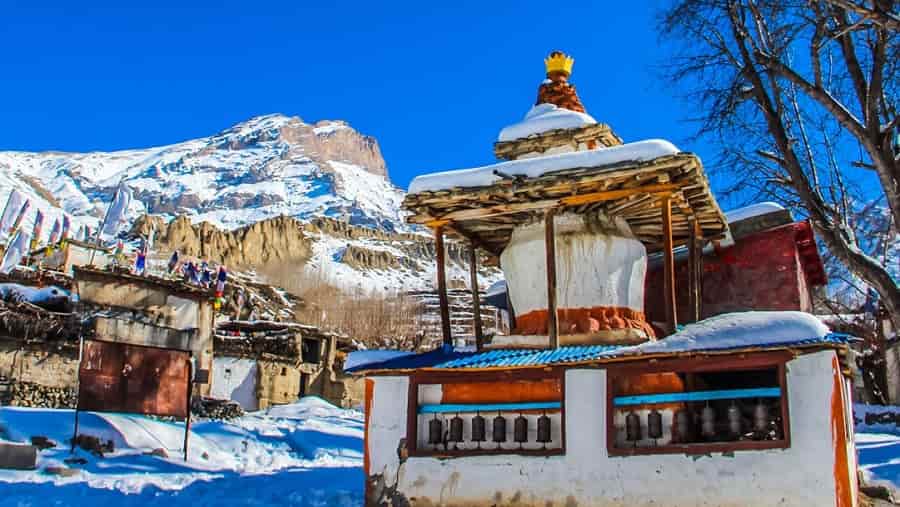Nestled in the breathtaking landscapes of Nepal, Muktinath is not only a sacred pilgrimage site but also a place of natural wonder. The weather in Muktinath plays a pivotal role in shaping the experiences of pilgrims, tourists, and locals alike. Let’s delve deeper into the diverse climatic conditions that characterize this enchanting region.

Geographical Location and Altitude
Perched at an altitude of approximately 3,800 meters (12,467 feet) above sea level, Muktinath lies at the base of the Thorong La mountain pass. This high elevation significantly influences the weather patterns in the region, making it a climatically diverse destination.
Seasonal Overview
Winter (December – February)
Winter in Muktinath brings a stark contrast to its surroundings. The temperature drops considerably, often reaching below freezing point. Snowfall is a common occurrence during this period, blanketing the landscape in white. Pilgrimage visits decrease due to the challenging weather, but the snow-covered vistas create an ethereal ambiance that captivates those who brave the cold.
Spring (March – May)
As winter fades, Muktinath undergoes a remarkable transformation in spring. The temperature gradually rises, and the landscape awakens with vibrant colors. The skies are clear, and the snow-capped peaks provide a breathtaking backdrop to the blooming flowers. Spring is considered a spiritually and visually enriching time to visit Muktinath.
Summer (June – August)
The monsoon season arrives in summer, albeit milder than in other parts of Nepal. The weather remains relatively temperate, and intermittent rainfall contributes to the lushness of the region. While some tourists may be deterred by the rain, others find the misty ambiance and verdant landscapes enchanting.
Autumn (September – November)
Autumn is widely regarded as the best time to experience Muktinath’s weather. The skies remain clear, the temperature is pleasant, and the surroundings are a harmonious blend of golden leaves and snow-draped peaks. This season witnesses a surge in pilgrim and tourist footfalls, offering a perfect environment for spiritual reflection and exploration.
Monsoon Factors
While Muktinath experiences a relatively mild monsoon season, the occasional rainfall can impact travel plans, particularly in the surrounding areas. The rain might affect accessibility and trekking routes, so travelers should remain flexible in their itineraries.
Temperature Extremes
The temperature range in Muktinath is quite extensive, varying from the bitter cold of around -10°C (14°F) in winter to a moderate 25°C (77°F) in summer. This wide spectrum of temperatures makes Muktinath an appealing destination for those seeking diverse climatic experiences.
Altitude Sickness Considerations
Due to its high elevation, altitude sickness is a genuine concern for visitors to Muktinath. It’s advisable to acclimatize gradually, stay hydrated, and avoid strenuous activities during the initial days to minimize the risk of altitude-related health issues.
Best Time to Visit
The choice of the best time to visit Muktinath largely depends on individual preferences. Spring and autumn offer pleasant weather conditions, making outdoor activities and exploration more enjoyable. However, those who embrace the chill of winter or the serenity of monsoon can find unique rewards during those seasons.
Local Insights on Weather
The local inhabitants of Muktinath view the weather as an expression of divine forces. Clear and sunny days are often seen as auspicious, while sudden weather changes are considered messages from the gods. This spiritual interpretation further adds to the mystical aura of the region.
Packing Tips for Various Seasons
- Winter: Pack layers of warm clothing, thermal wear, heavy jackets, gloves, and sturdy boots.
- Spring: Bring a mix of light and warm clothing, as temperatures can vary throughout the day.
- Summer: Pack lightweight clothes, rain gear, and comfortable hiking shoes.
- Autumn: Prepare for fluctuating temperatures with a combination of light and warm clothing.
Exploring Beyond Weather
While the weather undoubtedly shapes the ambiance of Muktinath, there’s a plethora of experiences beyond meteorological conditions. The ancient Muktinath Temple, dating back to the 19th century, stands as a testament to the spiritual harmony of the region. The diverse landscapes, including the barren Kali Gandaki Valley and the awe-inspiring Annapurna and Dhaulagiri mountain ranges, offer opportunities for exploration and adventure.
Conclusion
Muktinath’s weather is a symphony of contrasts, echoing the spiritual and natural diversity of this sacred site. Whether shrouded in winter’s icy grip, adorned with spring’s blossoms, refreshed by monsoon’s rain, or embraced by autumn’s golden hues, each season reveals a different facet of Muktinath’s allure.
Frequently Asked Questions
Is Muktinath accessible during the monsoon season?
Yes, Muktinath remains accessible during the monsoon season, but travelers should be prepared for potential disruptions due to rainfall.
What accommodations are available in Muktinath?
Muktinath offers a range of accommodations, from basic lodges to more upscale options, catering to various budgets.
Can I trek to Muktinath?
Absolutely, Muktinath is a popular trekking destination, and several trekking routes lead to this sacred site, each offering unique landscapes and experiences.
Is altitude sickness a serious concern for visitors?
Altitude sickness can indeed pose risks, but by acclimatizing properly, maintaining hydration, and listening to your body, you can minimize its impact.
What spiritual significance does Muktinath hold?
Muktinath is believed to be a place of spiritual liberation and enlightenment, symbolizing the journey towards freedom from the cycle of rebirth.

 Call
Call WhatsApp
WhatsApp Enquiry
Enquiry